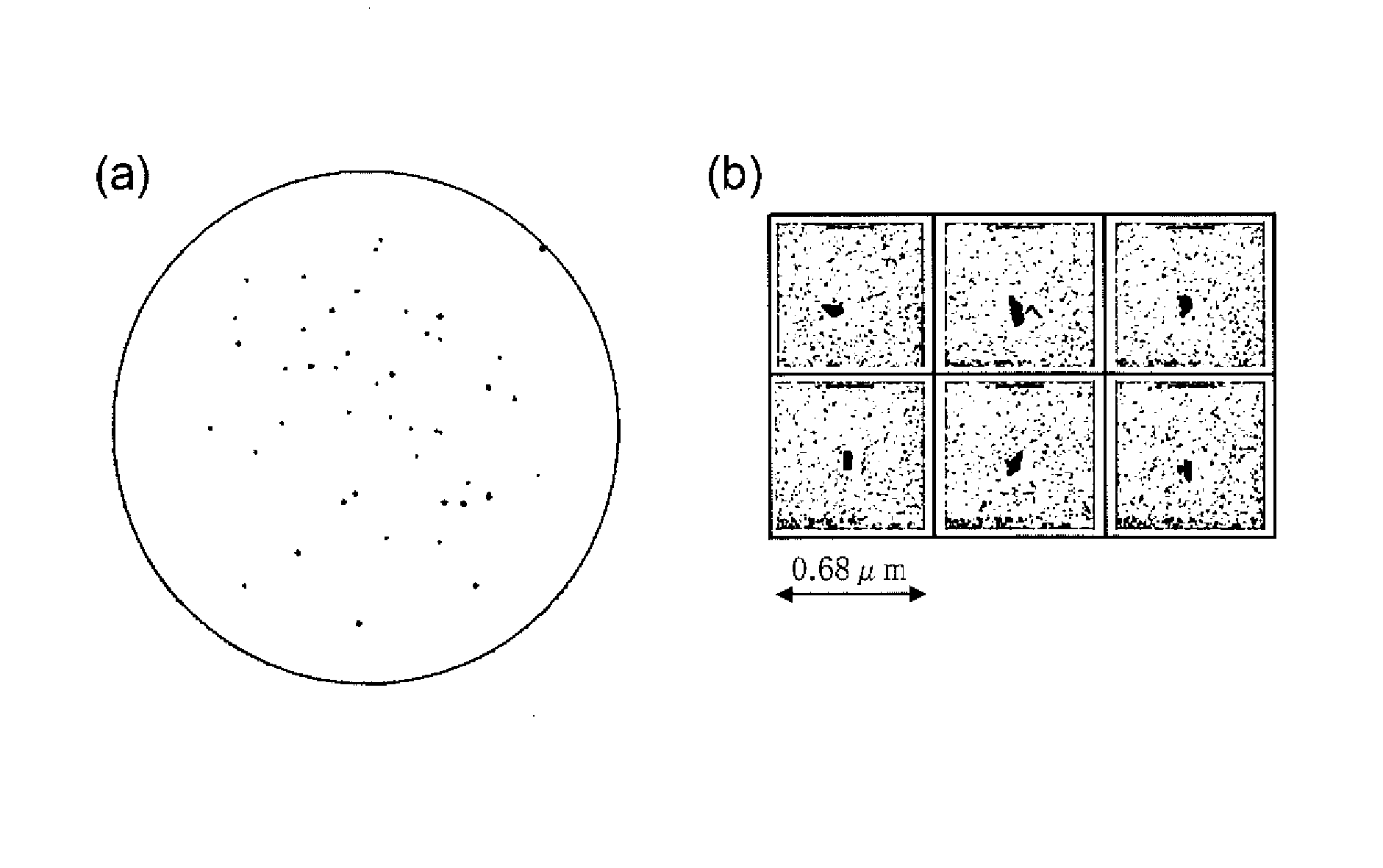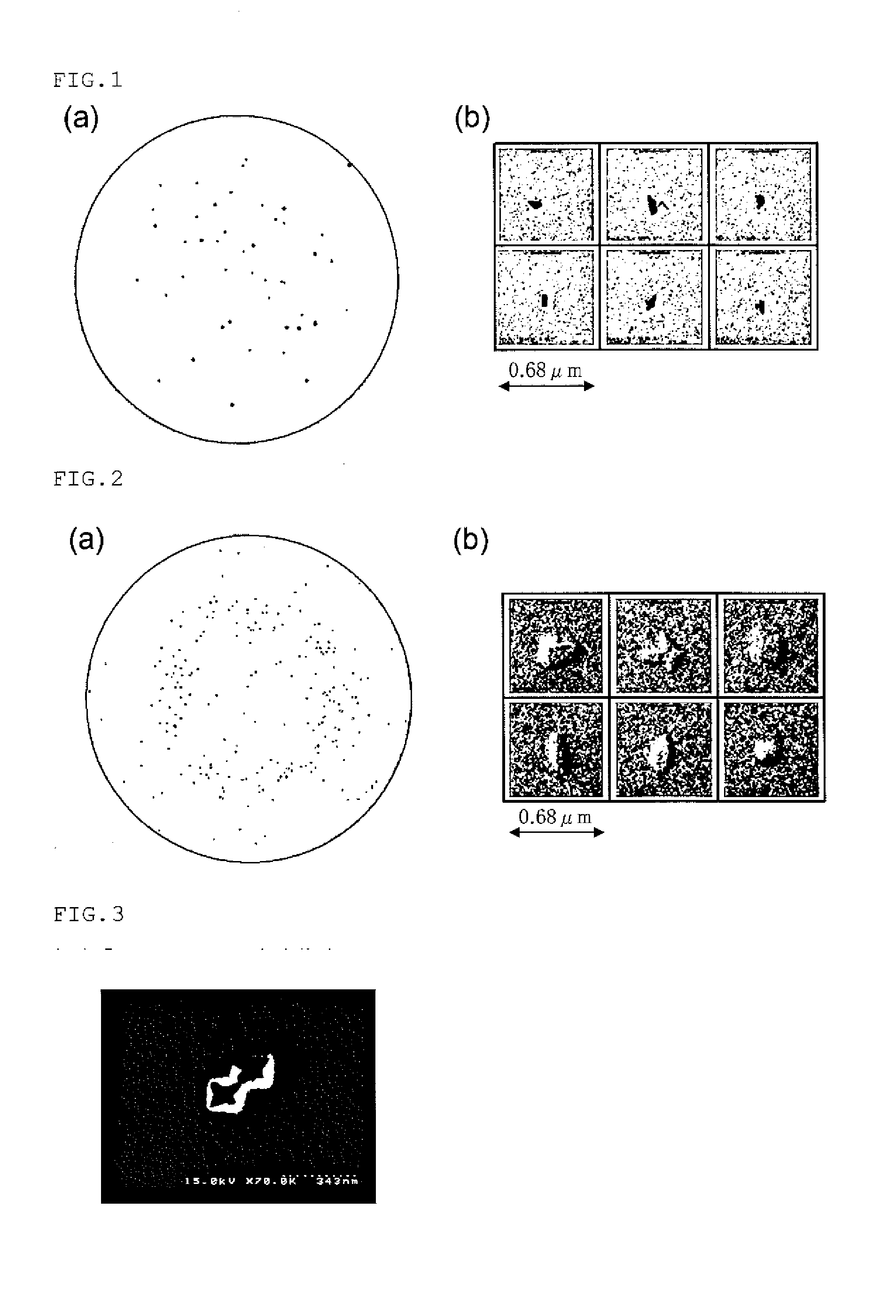Silicon wafer and method for producing the same
- Summary
- Abstract
- Description
- Claims
- Application Information
AI Technical Summary
Benefits of technology
Problems solved by technology
Method used
Image
Examples
experimental example 1
[0044]First, to determine a cause of generation of LPDs, a defect-free silicon single crystal of 300 mm in diameter was grown by filling a quartz crucible of 810 mm in diameter with 410 kg of polycrystalline silicon, melting the polycrystalline silicon, and then controlling a temperature gradient (G) and a growth rate (V) in a boundary region between a solid layer / a liquid layer of silicon as disclosed in Patent Literature 2. In doing so, boron doping was performed so that the resistivity became 10 Ω·cm, and the crystal axis orientation was set at . Slicing, lapping, etching, mirror-polishing, and the like which were industrially generally applied were performed on this defect-free silicon single crystal, whereby a mirror-polished wafer I was produced. This mirror-polished wafer I was measured by a particle counter (KLA-Tencor Corporation Model name=SP2 Detection particle diameter size: 0.037 μm or more). The detection result of an LPD map in a wafer plane is depicted in FIG. 1(a).
[...
experimental example 2
[0046]Next, a mirror-polished wafer II was produced from a defect-free silicon single crystal produced with a different quartz crucible in the same manner as in Experimental Example 1 described above, and LPDs were examined. A detected LPD map in a wafer plane is depicted in FIG. 2(a), and the observation results of the surface of the mirror-polished wafer II, the observation results obtained by the SEM, are depicted in FIG. 2(b). As depicted in FIG. 2(a), it was confirmed that LPDs were generated on the surface of the mirror-polished wafer II. Moreover, as depicted in FIG. 2(b), it was revealed that the shapes of the LPDs thus detected were convex hillocks. This difference in shape revealed that a cause of formation of LPDs in the mirror-polished wafer II was different from that of the mirror-polished wafer I.
experimental example 3
The Shape of a COP
[0047]It is known that a crystal defect is detected as an LPD. It has been reported that a COP (Crystal Originated Particle) is detected as an octahedral void defect (Non-patent Literature 3). To check if the defect shapes detected in the mirror-polished wafers I and II were related to the COP, a silicon single crystal of 300 mm in diameter was grown by doubling the crystal growth rate so that the COP was generated. Other growth conditions were the same as those of Experimental Example 1. The result obtained by observing the shape of an LPD of a mirror-polished wafer III by the SEM, the mirror-polished wafer III obtained by slicing this silicon single crystal and subjected to mirror-polishing, is depicted in FIG. 3. As depicted in FIG. 3, a defect caused by the COP was a void defect called what is termed a twin pit which is two partially-overlapping defects whose one side is surrounded in a [110] direction. This revealed that the defects of the mirror-polished wafe...
PUM
 Login to View More
Login to View More Abstract
Description
Claims
Application Information
 Login to View More
Login to View More - R&D
- Intellectual Property
- Life Sciences
- Materials
- Tech Scout
- Unparalleled Data Quality
- Higher Quality Content
- 60% Fewer Hallucinations
Browse by: Latest US Patents, China's latest patents, Technical Efficacy Thesaurus, Application Domain, Technology Topic, Popular Technical Reports.
© 2025 PatSnap. All rights reserved.Legal|Privacy policy|Modern Slavery Act Transparency Statement|Sitemap|About US| Contact US: help@patsnap.com



